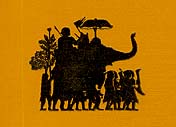

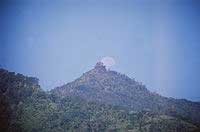
Long before King Divanika erected his stele in 456CE proclaiming Kuruksetra to be a holy place (tirtha) tribal people had gathered in the shadows of Lingaparvata looking in awe upon its lofty pinnacle reaching into the sky. But before Lingaparvata ever became known as Linga Mountain in praise of Lord Shiva this natural outcropping reaching 4645 feet into the sky was held in the minds of all indigenous people of the area as a great earth spirit where fire rituals and human sacrifices were a common practice.
Likewise in ancient India the greatest stories of mountains and gods were repeated orally for countless millennia until finally they were put in verse and the Book of Manu, Upanishads, Puranas, Rig Veda, Mahabharata, Ramayana and many more were all recorded for posterity. Today when we read these stories they seem like impossible accounts of how the gods of long ago traveled freely between earth's mountain tops and the heavens. And in a wholly desacralized cosmos where societies and nations have become predominantly secularized in their approach to existence, these ancient stories of gods and mountains are looked upon as fanciful myths without having any relationship to events taking place in the 21st century.
The gods of olden times have passed down to our civilizations of today their myths and legends by which to base our moral judgments and heroic deeds upon. If council and an audience with the gods were to be had it most likely would have taken place on a mountain top. These mountain abodes of the gods are well known and today they still hold special significance for cultures all around the world. In India and Tibet there are two mountains that are so revered for their acting as the home to Lord Shiva that sacred ceremonies are still conducted in their presence. One of the most sacred mountains in the world is Mt Kailash in Tibet and in southern India it is the sacred hill of Arunachela. Arunachela is regarded as a manifestation of Shiva himself and Mt Kailash is Shiva's actual abode.
In Laos, Lingaparvata became a focal point for austerities to Shiva in the fifth century under the vocable of Bhadresvara, the god of the Chams at My Hon-Son on the Champa (Vietnam) coast. The city of Kuruksetra and then later called Sreshthapura was the holiest ancient city for kings to make pilgrimage (tirtha yatra). In fact a 250 mile royal road runs from Angkor Wat directly to Vat Phu indicating there was a direct link to Vat Phu from the new Ankorean center.
There is a haunting living quality to Lingaparvata as it protrudes so uniquely into the sky almost as if some giant were pushing upward deep from within its rocky interior. From a distance Lingaparvata appears as a linga or even a small temple set on the summit where rituals to the gods would be performed. There is a Chinese document from the Sui dynasty (589-616CE) that mentions a temple on the summit of a mountain named Ling-kia-po-p'o, which is guarded by a thousand soldiers and consecrated to a spirit named Po-to-li. It was Georges Coedes, the famous French epigraphists, who transliterated Ling-po-p'o into Lingaparvata.
It is by all accounts a magical mystifying experience to witness this singular protuberance setting itself alone amongst the mountain tops behind Vat Phu and forever capturing the fascination and wonder of anyone who sets eyes on it.
Mt. Phu Kao immediately focuses your attention to the summit as no other small mountain can do. It's as if in its own way the mountain is trying to announce something profound or waiting to direct the eyes of the beholder to look at something very special. The mountain commands one to look in its direction because none of the other hills are as unique. It is unique and different and holds its own as a singular presence like none of the other hills. Surely such a mountain would be thought of having supernatural powers and perhaps in order to even address those powers rites and rituals would have had to be conducted long before any consideration would be given to scale its summit.
Here was a mountain top that was so singular in its appearance that innately one sensed there was something being conducted on its rocky protrusion that only the mountain itself knew about. The absolute profundity and sanctity that the mountain has held over the millennia has finally reached its symbolic identity as the linga of Lord Shiva himself.
This was Shiva's pillar of fire that endlessly went into the heavens and endlessly passed down through the earth. Here was the penultimate axis of the world and once the Brahmins from India saw this outcropping they could do none other than name this mountain Lingaparvata. This one linga would be impossible to move, and would provide the devotee with a substantive feeling of awe simply by recognizing the latent power of this mountain made it possible to communicate with the gods. It was on this mountain that the priests had developed the Cakravartin cosmology that in 400 years would establish the consecration of the Khmer Empire where Shiva, Vishnu, and Brahma would be the gods that would establish divine kingship for another 500 years.
If Mt Kailash in Tibet is considered the home of Shiva and Arunachela is considered an actual manifestation of Shiva then I would offer that Lingaparvata could be thought of as the temple of Shiva whereby divine communication with all the gods would take place. My justification for making such a statement and associating Lingaparvata with a temple gateway to meet the gods is by recognizing that the Khmer Empire got its spiritual guidance from the environs of Kuruksetra. The combination of Vat Phu, Lingaparvata, the sacred spring and King Jayavarman IIÕs inscription at Vat Oubmong indicate an auspicious focal point that merits calling Lingaparvata a temple gate way to the gods. It was in 802CE that King Jayavarman II consecrated the Khmer Empire and he became the "Cakravatin" and established the union between god and king and the beginning of the "Devaraja" cult worship.
Such auspicious and sanctified acts I believe originated at Lingaparvata (Shiva's holy temple to speak to the gods). Coincidentally on the same night of Shivarati when Shiva married Parvati is also the same night Shiva swallowed the poison brought forth from the churning of the milky ocean and thus saved the world. Shiva stabilized the earth on this night as a result of his communicating with the gods who asked him to save the world. Consequently we can also think of the holy mountain of Lingaparvata as the symbolic representation of Shiva saving the world from oblivion. The world axis (Skamba) held the universe in place and Lingaparvata acted like Mt Mandara; the mythical mountain used to churn the heavens and save the earth so it would not fall into the nether world.
On my two previous pilgrimages to Vat Phu, Lingaparvata could always be seen in the distance either hidden behind billowing clouds, or illuminated by the morning sunlight. Whatever time of day it was Lingaparvata commanded ones attention and was the symbolic center of focus for the Vat Phu complex.
I wondered if any of the villagers who lived near the mountain had ever heard of any unusual stories relating to Lingaparvata. Subsequently, I had the occasion to meet, Saenthavisouk, an 85 year old blind Laotian farmer from the village of Nong Duen in Champassak. This meeting came about as a result of participating in the first public group expedition to the top of Lingaparvata on February 9-10, 2006. The village of Nong Duen is close to a path that leads directly up to the top of the mountain. Thirty years ago, Saenthavisouk, and a monk named Narong, did a boon to Lingaparvata by carrying a 24kg candle to the very top. Saenthavisouk said they used to call the top of the mountain "Ngua-ou-sou-palath" the name given to the water buffalo which has a close identity to a bull, referring to Nandi the bull, which is Shiva's mount. He had mentioned he had seen unusual looking stones near the top of the mountain which I am certain were linga stones seeing as very recently 24 members of the Vat Phu museum carried a large linga down from the top of the mountain and placed it in the Vat Phu Museum.
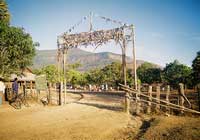
On the morning of February 9th, thirty five people assembled in the village of Nong Duen in preparation to climb to the top of Mt. Phu Kao. The climb was organized by Mr. Khamphang, director of the Champassak National Tourism Administration. This was the fourth time a group had climbed to the top of the mountain. The first was in 1993 by an Italian archaeology team, the 2nd and 3rd climbs were in 1997 and 1998 by a UNESCO team, and then after the area had been researched carefully it was decided by the Champassak authorities to take a small group of interested people to the very top in 2006. This was the first organized climb open to people not affiliated with archaeological research. For me it was an opportunity to experience the spiritual aspects of this very ancient mountain. The mayor of Champassak joined the group as well as Oudomsy Keosaksith, the deputy director of the Vat Phu museum. It was Oudomsy's knowledge and guidance that afforded me a deeper understanding of the mountain and the surrounding area. It was Oudomsy's fourth climb up the mountain having been on the previous three climbs.
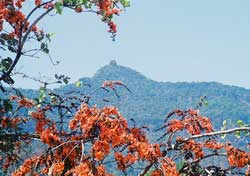
Before I begin the story of the climb to the summit I want to say that I was aware of the fact that one does not climb a sacred mountain, but instead does a circumambulation (pradaksina). However, it did not appear that this group was going to do a circumambulation but instead a direct climb to the top. Well before the climb I could find no references to a pradaksina on Lingaparvata. I had even written to Francis Englemann who has researched ancient sites in Laos for twenty years and has written extensively on Vat Phu. I asked him if he knew of a sacred path around the mountain and he replied back with this answer.
"I have no idea of a path for a pilgrimage around the mountain. You know that there has been a break in religious uses after the collapsing of the Khmer Empire, and a loss of the Siva cult by the local Lao-Tai population who reinterpreted the remains of the temple as an unfinished palace. If there has been such a sacred path it has been probably lost for centuries".
Perhaps any secrets about Lingaparvata are too powerful to be made known to the profane world. Perhaps the secret to a path around the mountain can only be revealed by slowly realizing how truly sacred this power point of sacredness really is. The nurturing of the cosmology of the Khmer Empire resided in this area and the power the indigenous people received from the land spirits (Chaothaen), ancestor spirits or ghosts (Phithaen) and Thaen who is the highest celestial being in heaven, can only be a subject of wonder. I could only hope that my climb to the summit would reveal a few of the secrets from these spirits.
At first I thought it would be very disturbing to have so many people going on a climb up this sacred mountain. But I soon learned that it took at least thirteen Laotian men to carry all the necessities to camp out on the mountain for one night. Not only were there carriers of the necessary supplies but at least six Laotian men who carried M16 and AK47 rifles acting as the advance guard who left a day early to clear the path of any wild animals and protect all of us in the evening. It took walking about 2km through open rice fields before we disappeared under the canopy of trees leading to the top of the mountain. At this point I was totally unprepared for what was about to follow. I clearly remembered climbing to Vat Oubmong and Tham Lek cave with Bountham and Chansavang on my 2nd visit to Vat Phu so I thought I was somewhat prepared for the difficulty of the climb up Lingaparvata. I wasnÕt. Slowly the climb up Lingaparvata became an ordeal of physical determination which taxed every amount of energy I possessed. The Laotian men, however, carrying what seemed to me to be impossible loads nimbly picked their way over stone after stone with only thongs for foot wear.
Slowly, hour after hour passed by and it seemed it would take an eternity to surmount the rocky ledges leading to the top. Small arrows were scratched onto the face of stones by the guides to help direct each step you took otherwise it would be impossible to know which stone to step on that would lead to the next stone and hundreds more to follow. The tree line on the lower part of the mountain was slowly being replaced by the most unbelievable bamboo forest the likes of which I have never seen before. Finding ones own way through this primordial labyrinth of nature would be impossible without guides.
And then the most unexpected experience happened to me. I stepped on an unstable stone, lost my balance and fell directly down the side of a steep rocky surface. My eye wear flew off my face and I lost the grip I had on my tri-pod and camera. I was immediately lifted out of the rocks feet first as I frantically motioned to the guides that I had lost my glasses. The camera and tri-pod survived, the glasses were found in one piece and I survived with only a few scratches on my legs and arms. I was lucky. The incident, however, caused me to reflect about climbing any further. I thought about this for some time as I regained my composure by taking a necessary break in the climb. I knew deep inside myself that I had come too far to abandon the climb.
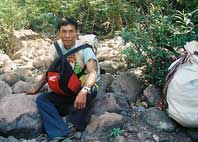 -
- 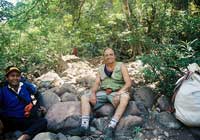
I readily admitted to myself that I did not have the strength I thought I had but knew I had to continue. Both my tri-pod and camera along with my backpack were taken over by Venh Xay, one of the Laotian climbers, who also became an invaluable aid to both my ascent and decent on Lingaparvata. I could not imagine how he could carry so much on his body with only wearing a simple pair of flimsy shower thongs. The sheer determination to continue climbing made everything else around me transform into some phantasmagorical landscape. The bird calls had a deep echoing tone which sounded like "a-tok-a-lok", "a-tok-a-lok" repeating endlessly and fading into the distant tree tops. The trees became so incredibly enormous both in height and width that I really did not believe I was on the same mountain. Caves appeared to recede endlessly into the mountains and rocky protrusions jutting out from the cliffs defied all sense of gravity. Serpentine vines of unbelievable thickness were hanging from tree in contorted spirals cork screwing themselves between every imaginable crevice and mountain stone.
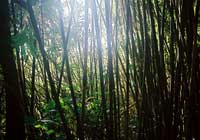
The bamboo forest became a dark green landscape of endless masts reaching to the sky. And all through this amazing visual and aural odyssey I was still groping up the mountain thinking I had reached the limits my legs could carry me any further, but nevertheless I continued climbing until we finally reached the campsite.
I assumed we were going to camp until morning and then climb to the top of Lingaparvata. Mr. Khamphang, however, put an end to that thought and made the decision to continue climbing. At that point I did not think I could find the energy to climb another hour or more but again I had no choice if I wanted to experience what I had planned so long for. Slowly I began to realize this second part of the climb was even more rugged than the climb to the base camp. Very thick forest growth with long hanging vines, bamboo trees in tight clusters and wild grass were all intertwined creating a seemingly impossible maze to find ones way through. I could see that the sun was slowly setting behind the top of the mountain and I knew it would be dark soon and couldn't help but think the morning would have been a better time to have gone to the top. But step by step I found myself pulling on long thin vines conveniently placed by nature so I could hoist myself up through narrow rock ravines, before I finally turned for one last switch back and found myself standing next to the massive towering rock out cropping named Lingaparvata; assuredly the ultimate natural linga in the world.
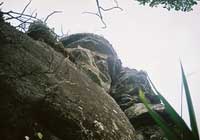
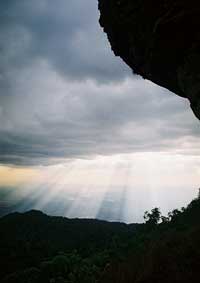
The rays of the setting sun were streaming through the clouds like so many golden shafts of light creating a curtain of luminescence as far as the eye could see. It was like standing on top of the world. Vanh Xay made sure my footing did not go though the holes underneath the thick mountain grass and it was all too obvious that nobody had been here for a very long time judging by the growth of all the plants and trees.
The mayor of Champassak was being interviewed by two reporters from Pakse and everyone was taking pictures. I was so thoroughly exhausted I wasn't quite sure what to think about. Oudomsy Keosaksith guided me around to the north face of Lingaparvata showing me a natural altar on the side of the rock face where the UNESCO team had found a Shiva linga in 1997; the same linga that is now on display in the Vat Phu Museum. Incense was burning and candles were lit and placed on the flat stone as other members of the group were paying their respects. Yuji Iwatsuki, and engineer living in Champassak, offered me a candle whereupon I concentrated on offering my own austerities to Shiva and Lingaparvata.
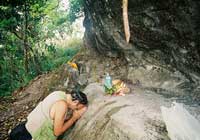
I broke pieces of bread and set them on the stone altar along with pouring water on the face of the stone as if I were in some holy sanctuary. I had no other strength other than what it took to kneel down in front of this massive stone. My legs were burning from the inside out as every muscle in my body was stressed after such a long climb. When I pressed my forehead against the cool stone I had the thought that someone had opened a large hidden door on the face of the stone and I entered the mountain experiencing a momentary sense of quiet that engulfed me completely. I was in deep meditation partly due to a moment of relaxation and partly due to loosing my concentration in solemn respect for the opportunity to be where I was. I could feel the enormity of this stone outcropping, and if ever I was going to be at the threshold of the gods it was then at that singular moment. I felt very small and insignificant next to this pillar of stone and as I slowly opened my eyes and leaned back I looked straight up at the towering stone Lingaparvata.
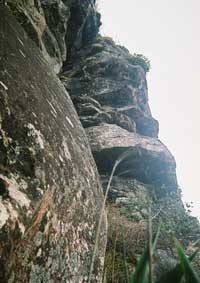
The commanding presence of the stone sent cold shivers down my spine and a sense of being able to enter the realm of the gods once again entered my mind. I reached the door way to immortality, the place where for over a millennium Kings would come to pay their respects. It was a moment of rare sanctified bliss to be immersed in such an ancient setting.
Slowly my eyes left the top of the mountain and as I slowly lowered my gaze I could see many small caves which were naturally hewn into the stone providing shelter for birds, animals and anything else that crawled. I rose to my feet and walked back to witness the vast expanses of land which stretched south where the Mekong River could be seen winding its way ultimately into Cambodia.
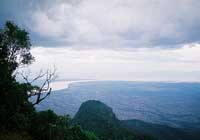
The setting sun was reflecting on the river like some giant shimmering serpent slithering across the earth. For that moment as I stood next to this massive mound of stone I was conscious of a larger presence next to me, a presence composed of stone but not any ordinary stone. This stone had a distinctive identity as a sentinel sent from the heavens to protect the holy land of Kuruksetra. This tone touched the clouds and I sensed in some very unfamiliar way that Lingaparvata had a sentience or recognition of the other. Partaking in this pilgrimage put into perspective for me the brief encounter we humans can have with the eternal presence wrought from nature. From this one particular natural protuberance pointing to the heavens was a sacred stone that had been venerated for countless millennia by people who have revered the mountain as a sacred temple in the heavens as well as fearing its presence. The Chinese annals testify that over 1000 men guarded the top of this mountain.
Should I have gone to the top of Lingaparvata? Did I violate the integrity of this sacred stone by my own lack of preparedness or not performing enough rituals to honor its presence before I climbed up to the top? Was I forewarned during my ascent to reconsider my entering this holy realm of the gods, and if perchance I have entered where one is not allowed will I incur the wrath of Lord Shiva himself? I believe I was given a warning during my climb to the top of Lingaparvata which forced me to scrutinize my decision to continue the journey up this most holy of mountains. But then all those concerns and doubts dissolved in my mind and the vast expanse of land that stretched out before me overcame my awareness and for a brief moment I really felt I was in the realm of the gods.
It was impossible to do a circumambulation around the top of this massive stone outcropping. The enormity of being directly next to the outcropping demanded that you heed the dangerously steep ledges which drop precipitously down the side of the mountain. It was then that I realized Lingaparvata commands its own distinctive presence protruding the way it does into the clouds.
All the effort of climbing up the mountain for nearly nine hours culminated in a simple act of standing and peering out over the vast plains laid out before me as far as the eye could see.
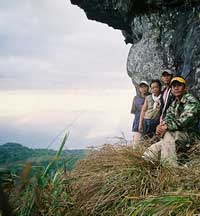
As a group we were few in number to be the first to come to this venerated mountain top where countless secrets and sacrifices were held deep within the stones memory. How many offerings had been made to this sacred stone over the millenniums nobody will ever know. Directly below Mt Phu Kao the smaller Hong (bird) mountain symbolizing Vishnu's mount Garuda, and below Hong Mt. rested the even smaller Nak (snake) mountain symbolizing the nagas protecting the land. These three mountains reaching to the heavens acted as sentinels over the holy land of Kuruksetra.
And far to the south the setting sun was reflecting off the Ban That baray near the village of Ban That (village of the towers) in the Sukhuma district of Champassak province where King Suryavarman II erected three stupas and a stele in honor of King Dharanindravarman I. The first recording of the sanskrit on a stele in front of the three towers was done in 1876 by a Mr. Harmand and later translated by the Dutch scholar Mr. Kern and published in the Annales de l'Extrême Orient. In 1901 the French epigraphist Etienne Aymonier expanded on Kern's translation in his book "Khmer Heritage in Thailand"; now available from White Lotus Press in Bangkok.
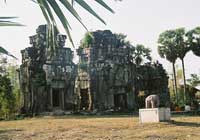 -
- 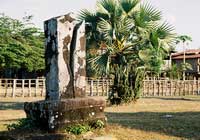
Today these three stupas are referred to as That Sampang. This furthermost southern gate leading to Lingaparvarta was a way to recognize the spirit Lingaparvata has even though it is over 30km to the north of the village of Ban That. SuryavarmanÕs temple is further testimony to how important it was to pay respects to this sacred mountain and the land around it. I could not help but think, as I was standing high on top Mt Phu Kao, that I was reliving a moment in history when the Brahmin priests offered austerities to Shiva in much the same way as I had done in my own small way that day. Surely nothing of the mountain had changed over the millennia as the eternal presence of Shiva was forever symbolized by Lingaparvata. The holy trinity (trimurti) was infused into the sacred stone outcropping looming over the land of Kuruksetra as a reminder to all humans that the gods had fashioned a part of their kingdom in the heavens by making Lingaparvata on earth.
No sooner had we arrived at the top it was time to struggle back to our campsite. The Mekong River was winding its way south reflecting the golden rays of the sun and for all those brief moments I experienced the lofty pinnacle of Lingaparvata. The sky slowly turned black and had it not been for a small travel light I brought I would have never been able to see where to put my feet to get down from the top. The moon was now shinning through e trees and the haunting hooting of an owl resounded in the cool mountain air. Venh Xay was directly behind me along with Oudomsey and Khamphang from the tourist office who took my hand in front and guided me each step of the way down to the campsite. With unfounded determination coupled with the need to find the strength to grab hold of vines and climb down rocky ledges I finally made it back to the campsite.
The Laotian men were busy preparing campfires and setting up tents for the evening. After eating sticky rice, chicken and fish paste (pla) I retired to my tent. It was getting colder on the mountain and a chill overtook my body. Somehow I rolled myself up in the few coverings I could find and finally fell asleep. In the very early hours of the morning I was awakened by a very strong howling wind which forced its way through the trees making everything sway furiously creating loud sounds like ocean waves crashing on the shore. I could hear the owl calling out with its distinctive hooting and got out of the tent and just stood there looking at the clouds speeding across the face of the moon while listening to the sound of the strong wind blowing in the trees. I found myself in a world like no other I had ever been in before. Everyone was asleep and the amber coals from the campfires could still be seen glowing in the dark.
The moon could be seen through the tops of the trees as it was traveling on its ecliptic path passing by the Gemini twins Pollux and Castor (Rahu and Ketu in Vedic astronomy) heading toward Regulus one of the four guardians of the heavens who guarded the north. The other three sentinels ruling the heavens were Aldebaran watching the East, Antares watching the West, and Fomalhaut watching the South. These were the four stars that marked the two equinoxes and two solstices. Regulus, the royal star, when in 3000BCE marked the summer solstice. And among the lunar mansions in Vedic astronomy Regulas was in the nakshatra that bore the name Magha, "the mighty". These were a few of the celestial coordinates I was trying to put together to understand my place in the universe that evening.
I immediately recalled my entrance into the central sanctuary at Vat Phu when I passed under Kirtttimukha and the twins guarding the central shrine. Now I found myself directly under the twins in the heavens who have played such an important role in all the creation myths on earth especially the one concerning the churning of the milky ocean. It was Rahu and Shiva who were about to go into battle because Rahu took a taste of the elixir of immortality. I felt I was about to encounter something profound that evening? There was no mistake that Rudra was howling furiously in his lofty temple. What was he trying to say howling through the tress that evening? If even there was going to be an opportunity to be in Shiva's presence it was then standing under the moon on top of Lingaparvata. This is why I came to Lingaparvata and unfounded as it may seem I was completely absorbed by the spirits of the mountain.
Then as if by some unknown force I was transported by the wind and found myself riding on the back of Lakshmi's beautiful white owl Ulooka as it announced its way up through the tree tops and into a temple floating over Lingapavata. Rudra appeared with the most grimacing look which was enough to frighten anyone beyond hopes of living to see another day. This horrible face of Kirttimukha was to experience unimaginable terror, but having no reason to fear Shiva's wrath his horrific face of glory slowly transformed before my eyes as all the elements in and around Kuruksetra slowly came forth and changed his menacing gaze into the celestial image of Lord Shiva.
The very top of Lingaparvata itself transformed into a chignon on top of Shiva's head, the long spiraling vines draping from the trees became his long flowing hair with the moon becoming a crescent diadem of iridescent white light adding to his godly presence. The Mekong River appeared as a giant serpent wrapping itself around his body and its hooded head appeared over his shoulder. The deers in the forest shed their skins which then draped over his body and the base of Lingaparvata turned into his heavenly vehicle; Nandi the bull. All the stars radiated down from the heavens casting shafts of starlight next to his left side forming his heavenly consort Parvati. The most ancient of trees that reached to the heavens became his trident, and the sacred spring waters flowed from his hair. It was the most resplendent sight to behold. Then from between ShivaÕs forehead (his ajna-cakra) there slowly appeared a light which grew in intensity blinding my eyes and forcing me to cover them with my hands. I took one hand away hoping to see his celestial presence only to find the moon directly above me peering through the tree tops while a few cool rain drops fell on my head. Transfixed and stunned all I could do was look around the campsite wanting to wake everyone up and tell them of my vision. I knew it would have sounded much too unbelievable. What I do know for sure is I was standing on the top of Lingaparvata in those early morning hours of February 10th, 2006, and only by trying to recall standing under those wind blown trees in the early hours of the morning did the vision of all those nature spirits appear in my mind. I knew then that morning was a very different moment in my life so I waited for two weeks to pass when the night of Shivarati came on February 26th before I would write down my experience of seeing Shiva and Parvati in their celestial temple.
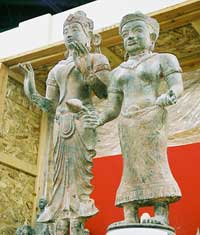
As a result of recording my visions I have learned how to translate what appears to be just a normal everyday occurrence into vivid other worldly images. I have discovered that behind the surface of our world that we experience with our five senses there is much more to be seen. There exists another world that is not comprised of an orderly progression of events but a multi-dimensional world that can be perceived in many different ways.
I suppose you could say it was only my imagination that portrayed events the way I wanted to see them and in reality these imaginings were nothing more than personal illusions and fantasies. In that case Vat Phu has to be one of the most spectacular examples of how fantasy became a reality as men carved onto stone some of the most splendid images of a kingdom ruled by gods who were in touch with the immortal realms where Lord Vishnu could be found sleeping on the waters of the universe waiting to begin another age silently joined by all the gods in a holding room at the museum.
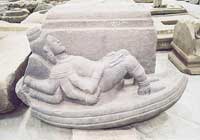 -
- 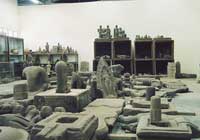
But now, all I could think of was how to find the strength to walk down over these mountain stones that were at one time fashioned into the most beautiful temple adornments reflecting the order of the universe. I am sure I was briefly given a glimpse of Shiva's radiance before his wisdom blinded me and once again was joined with mortal men. It wasnÕt yet the time for me to leave my "self" at the threshold of Coomaraswamy's "sun doors" so my soul could reunite with eternity.
When the rays of the morning sun broke through the trees everyone was up and about eating some food and preparing for the five hour descent to the village of Nong Duen. My legs felt like pieces of stiff rubber without bones to hold me upright, but instead they gave way to a wobbling sensation when I tried to walk. I thought for sure I could never walk back down those steep cliffs, winding ravines, and stone path ways formed by the rushing waters from the mountain top. But an instinctual reflex took over keeping me from falling enabling me to slowly climb down the mountain lifting my legs over fallen tree trunks, and always getting a helping hand from Venh Xay. It was the last 2km where I felt part robot and part human as my knees could hardly bend and only by some swaying waddle of my whole body could I keep going. I must have looked quite humorous to anyone looking at me, but being the last to arrive at the village I experienced those final miles of the rice fields by myself.
When I finally reached the village I think I provided a spectacle for the villagers by being the only white foreigner. But without the slightest embarrassment I slowly walked up the short stairs into the village hall as everyone was cheering as I sat down to join in the festivities. The sound of music and voices seemed to be coming further away than right in front of me. I had left the immediate control of my senses and let something else carry me along to come down the mountain. I know this all must sound so exaggerated but its how I really felt at the time. I literally did not have the strength to climb this mountain yet by some inner determination I over came obstacles even with insurmountable difficulties. I have heard the same sense of over coming obstacles from countless stories on human triumph and now I had a direct experience that I could use in understanding how we humans possess an inner strength to do something if we really put our minds to it.
Slowly the cheering and music came into focus and with a few drinks of Lao's favorite rice alcohol called "Lao Lao" I reconnected with my body only to discover I was in the middle of a very large ceremony. The ceremony I came to leran follows an ancient Lao tradition of healing. Dr. Wajuppa Tossa has compiled a chapter on Lao Folk Medicine and Remedy in his Lao Folk Literature book on the "Baa sii suu Khwan" ceremony. He states,
" It is believed that each person's well-being depends on their khwan or spirit. Each person has 32 khwan dwelling within his/her person. If any of the khwan is frightened, the person may fall ill. To help comfort a person to feel that the khwan is contained with his/her body a ceremony is organized. This ceremony is called "baa sii suu khwan" or "suu khwan baa sii" (the ceremony of calling back the spirit). This ceremony is commonly practiced among the ethnic Tai people in Southeast Asia including the Thai/Lao people in the north, the northeast, and Laos. Baa sii suu khwan is a ceremony held to bless a person with health and happiness both physically and spiritually".
After learning this I was extremely grateful that I participated in this ceremony having been frightened with seeing the face of Kirttimukha in my vision. For the first time a special certificate was presented to all those invited to make the climb. Khamphang was the master of ceremonies and in the center of the village pavilion a ceremonial tray (phaa khwan) was prepared which held a many level beautifully designed cone made from banana leaves which held flowers, incense sticks, candles and cotton strings.
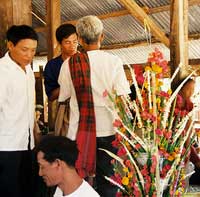
A person versed in the ancient Brahman chants would then call out "ma yoe khwan oye (Come spirit, Please Come)" and every one echoed the refrain together. A special flower branch would then be dipped in Lao whiskey and sprinkled on everyone in the ceremony. At the end of the chanting everyone picks a cotton string from the cone and ties it to a personÕs wrist to keep the spirit within the body of the person and leaves it on for three days. This was a most memorable occasion for me to experience the warm feelings of all the villagers of Nong Duen. After the ceremony all the villagers prepared many different Lao food dishes and it was truly a time of healing and rejuvenation.
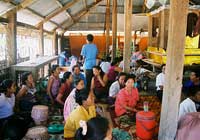 -
- 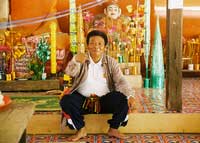
As far as experiences go the opportunity to scale Lingaparvata seemed like I had visited a lost world more ancient than all the temples built by the Khmers, and in truth Lingaparvata will still be on this earth long after the civilizations of today vanish. Partaking in this pilgrimage put into perspective the brief encounter we humans can have with the eternal edifices of nature. Lingaparvata has been venerated for countless millennia by people who have revered this temple of nature reaching to the heavens as the most feared and most respected place to pay tribute to other worldly spirits.
I am not so sure that our imaginations of things that are other worldly are based on fantasy but are in fact the faintest vestiges of a world where humans were in direct contact with godly realms. Perhaps now as the human race enters the next "great year" (manvantara) with a new world age occurring in the constellation Aquarius will more of these dormant insights into the realms of the gods be reawakened, and what now appears to us as fantasy and illusion will be made manifest through a new transformative vision of spiritual awakening. It will require a recognition that we humans are in fact mutating and shedding our conceptions of reality based on gross materialism into one based on etheric realms where the illusiveness of consciousness is based on light and illumination enabling a new interpretation of our "beingness" in the universe. Stated in another way we are leaving the cycle of the kali yuga and once again, after 26,000 years, entering the golden age of the satya yuga.
But, now that I have entered this most holy of mountains I can not be justified in saying to others not to seek the temple of the gods. But what I can say is that reverence of this mountain should be carried with you when you do decide to enter Shiva's realm. Perhaps then Shiva will be forgiving. Albert Schweitzer (1875-1965) the philosopher who won the Nobel Peace Prize in 1952 had a motto which I have always cherished. It reads "veneratio vitae" (reverence for life). I believe this should always be kept in mind when entering ShivaÕs realm.
The following day the opening ceremony of the Vat Phu festival was taking place and one of the visiting dignitaries was Dr. Patrizia Zolese a world renowned archaeologist who has been instrumental in restoring the ancient ceremonial road leading to Vat Phu. Through the Italian Archaeological Mission the lotus columns and sandstone causeway are being restored to their original grandeur. I had the opportunity to speak at great length with Dr. Zolese about the history of the Khmer empire, her future plans of restoration at Vat Phu, and the attraction of tourism to Vat Phu.
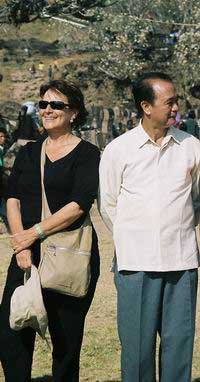
I mentioned to Patrizia that I had climbed to the top of Lingaparvata the previous day and she immediately exclaimed, "Its forbidden to climb Lingaparvata". You can imagine how I felt hearing her say that. I felt I had stolen something as well as a sense of guilt for violating the sanctity of the mountain which she definitely felt to be too sacred to step foot on.
Her feelings were that Mt Phu Kao is a very sacred mountain and to introduce tourists to the mountain will only bring trash, ruined flora and fauna, and worst of all the tourists will be taking stones as souvenirs or carving their names in the sacred outcropping of Lingaparvata. Mr. Khamphang has said he has made every effort to educate his team, the climbers and the tourists to these concerns. These are legitimate concerns that are plaguing all spiritual sites the world over. Luang Prabang, once a quiet peaceful Buddhist Village is now filled with western style pizza shops and the catering to tourists has forever changed this quiet village.
Vat Phu is the 2nd World Heritage Site in Laos and from what I could tell the leaders of Champassak will maintain that special quality that makes this a very spiritual place to visit. However, with the increase in tourists and the number of activities that are planned this strict adherence to keeping the mountain free form trash and damage will become increasingly more difficult. I hope that my own participation in the first organized tourist climb to the top of Lingaparvata does not bring disrespect to the sanctity of the mountain but adds to its importance as a sacred center deserving respect and care not only for the Lao people to enjoy but for all people to experience the special quality the mountain offers. This one was of the most memorable events of my life and I wouldnÕt want the memory of that purity of nature to be altered by disrespect for the holy land which Lingaparvata and Vat Phu are a part of.
Perhaps it's best if a viewing platform were built where tourists could look at Lingaparvata and leave this sacred temple to the domain of the gods. Considering all the initiations and knowledge one had to acquire to enter the holy sanctuary of Vat Phu during the reign of the Khmer kings this would be in keeping with the spirit of Vat Phu. However, the profane world seems to be loosing this quality of respect for sacred sites. Let Lingaparvata exist in peace and give to it the respect it deserves and recognize it as Lord ShivaÕs temple to the gods.
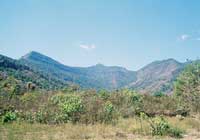
For every person considering entering Lingaparvata it is up to their own conscious to be their guide. Today Lingaparvata is in a pristine state, but it can not possibly remain that way if thousands of tourists trample the ground that supports the life around the sacred mountain. Careful decisions must be made to protect Lingaparvata and not extinguish the spirits which live on this mountain. Perhaps this is why Rudra was howling in those early morning hours, and why I was returned to the earthly realms to tell every one of Rudra's concerns. It was a howling to keep away this onslaught of tourism that will change forever the days and nights on this holy mountain. The gods did speak to me after all.
Directions to Lingaparvata:Directions to Lingaparvata
Other stories related to the Khmer Empire.
Stones in the Sky - Introduction
Part I - Stones in the Sky - Prelude to Pilgrimage
Part II - Stones in the Sky - The 2nd Entering of Cambodia - July 27, 2002
Part III Section #1 - Stones in the Sky - The secrets of Angkor Wat - March 2003.
Part III Section #2 - Stones in the Sky - The secrets of Angkor Wat - March 2003.
Part IV - Stones in the Sky - Journey to Preah Vihear - May 2004.
Part V - Stones in the Sky - Journey to Beng Mealea - October 2004.
Part VI - Stones in the Sky - Pilgrimages to Vat Phu - April 1-4, 2005, October 21-25, 2005
Apsaras and Devatas - Photo documentation of female divinities at Angkor Wat.